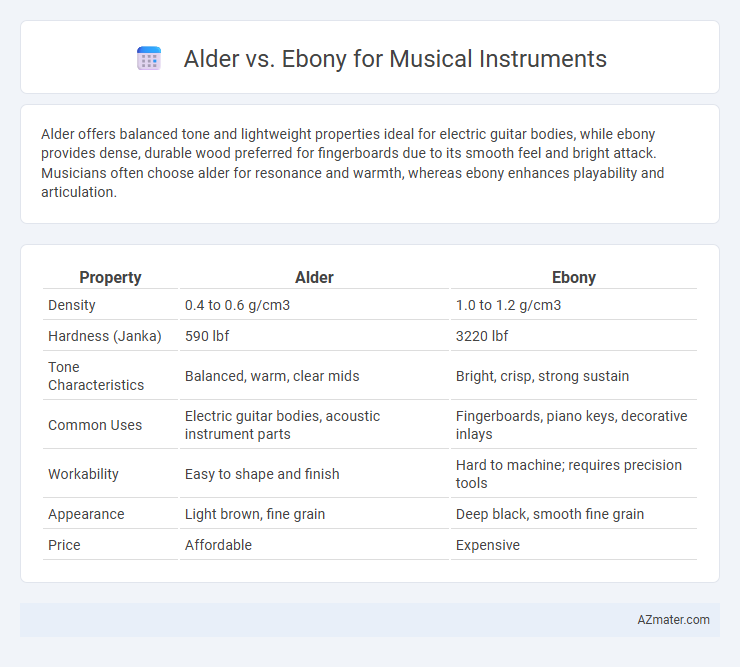Alder offers balanced tone and lightweight properties ideal for electric guitar bodies, while ebony provides dense, durable wood preferred for fingerboards due to its smooth feel and bright attack. Musicians often choose alder for resonance and warmth, whereas ebony enhances playability and articulation.
Table of Comparison
| Property | Alder | Ebony |
|---|---|---|
| Density | 0.4 to 0.6 g/cm3 | 1.0 to 1.2 g/cm3 |
| Hardness (Janka) | 590 lbf | 3220 lbf |
| Tone Characteristics | Balanced, warm, clear mids | Bright, crisp, strong sustain |
| Common Uses | Electric guitar bodies, acoustic instrument parts | Fingerboards, piano keys, decorative inlays |
| Workability | Easy to shape and finish | Hard to machine; requires precision tools |
| Appearance | Light brown, fine grain | Deep black, smooth fine grain |
| Price | Affordable | Expensive |
Overview of Alder and Ebony Wood
Alder wood is a lightweight, moderately soft hardwood known for its balanced tonal qualities, offering a clear, full-bodied sound with pronounced midrange frequencies ideal for electric guitar bodies. Ebony wood is a dense, hard hardwood prized for its durability, smooth texture, and bright, articulate tonal characteristics, commonly used for fingerboards and piano keys due to its resistance to wear and excellent sustain. Both woods are favored in musical instrument manufacturing for their unique acoustic properties and aesthetic appeal, with alder providing resonance and warmth while ebony delivers precision and brightness.
Physical Properties Comparison
Alder wood is lightweight with a balanced grain, offering moderate density around 420 kg/m3, which contributes to a warm, resonant tone favored in electric guitars. Ebony is significantly denser, approximately 1280 kg/m3, known for its hardness and durability, often utilized for fingerboards and bridges due to its smooth texture and resistance to wear. The contrasting physical properties impact sustain and tonal clarity, with alder providing a softer attack and ebony delivering sharper, more articulate sound projection.
Tonal Characteristics
Alder offers a balanced tonal profile with pronounced midrange, clear highs, and a tight low end, making it ideal for versatile electric guitars. Ebony provides a bright, articulate sound with strong attack and sustain, enhancing note definition on fingerboards and bridges. Guitarists seeking warmth and clarity often favor alder bodies matched with ebony fingerboards for tonal complexity and durability.
Suitability for Different Musical Instruments
Alder wood offers balanced tonal qualities with clear mids and a smooth resonance, making it ideal for electric guitars, especially for genres like rock and blues. Ebony, known for its density and hardness, provides a bright, articulate sound with excellent sustain, commonly favored for fingerboards and piano keys in classical and jazz instruments. The choice between alder and ebony depends on the instrument's tonal requirements and playability preferences, where alder suits body construction for warmth and ebony excels in components demanding precision and durability.
Durability and Longevity
Alder wood is prized for its balanced weight and moderate hardness, offering solid durability and resistance to wear in musical instruments such as electric guitars. Ebony, known for its exceptional density and hardness, provides superior longevity and resilience, especially in fingerboards and bridges, making it highly resistant to scratches and wear over time. While alder offers a lightweight and stable body option, ebony ensures enhanced durability in high-contact areas, contributing to the instrument's lasting performance and structural integrity.
Workability and Crafting Challenges
Alder wood offers excellent workability for musical instruments due to its lightweight, even grain, and ease of shaping, making it ideal for electric guitar bodies and parts. Ebony, known for its dense, hard texture and fine grain, poses crafting challenges, requiring precision tools and skilled labor to avoid splitting and ensure a smooth finish. While alder facilitates faster production with fewer tool wear issues, ebony demands meticulous craftsmanship for durability and a polished aesthetic.
Aesthetic Appeal and Finishes
Alder wood offers a smooth, consistent grain with a light reddish-brown hue, making it ideal for vibrant, glossy finishes that enhance a sleek, modern aesthetic. Ebony features a dense, fine grain with a deep, jet-black color prized for elegant, high-contrast finishes that emphasize luxury and sophistication. Both woods provide distinct visual appeal, with alder favoring bright, warm tones and ebony excelling in dark, dramatic looks for musical instruments.
Environmental Sustainability
Alder wood is favored in musical instruments for its lightweight properties and moderate environmental impact due to faster growth rates and sustainable harvesting practices. Ebony, while prized for its density and rich tonal qualities, faces significant environmental concerns because it grows slowly and is often sourced from endangered forests, leading to stricter trade regulations under CITES. Choosing alder over ebony supports more sustainable forestry management and reduces the ecological footprint associated with instrument manufacturing.
Price and Availability
Alder wood is generally more affordable and widely available for musical instruments, making it a preferred choice for beginners and mid-range guitars. Ebony, being a dense and exotic hardwood, is significantly pricier and less common, often reserved for high-end fingerboards and accents. The scarcity and cost of ebony impact its availability, leading manufacturers to use alternatives or composite materials to meet demand.
Choosing the Right Wood for Your Instrument
Alder offers a balanced tone with clear mids and lightweight durability, making it ideal for electric guitar bodies that require a versatile sound. Ebony, renowned for its dense, hard texture, provides exceptional sustain and bright attack, commonly preferred for fretboards rather than full instrument bodies. Selecting alder or ebony depends on whether the emphasis is on tonal warmth and weight reduction or on hardness and string response for precise playability.

Infographic: Alder vs Ebony for Musical Instrument
 azmater.com
azmater.com